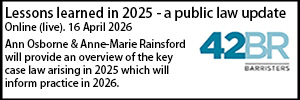The Court of Protection, s.48 and interim orders
- Details
Lee Parkhill analyses an important Court of Protection ruling on s. 48 of the Mental Capacity Act and interim orders.
In DP v London Borough of Hillingdon [2020] EWCOP 45, the Vice-President considered when s. 48 of the Mental Capacity Act 2005 should be engaged, and the threshold for s. 48 orders. The judgment explains that, although s. 48 is routinely used to make declarations, in fact s. 48 confers no declaratory power. The judgment also provides welcome clarification as to the evidence of incapacity required to engage the s. 48 jurisdiction.
The facts
DP is 72 years old. He lives in a care home. He is deprived of his liberty, and a standard authorisation is in force. He brought s. 21A proceedings to challenge the authorisation. At the first hearing, DP argued that the mental capacity assessment was deficient, and insufficient to show that he lacked capacity to consent to his placement. DP argued that the court should terminate the authorisation immediately. The court made no order in respect of the authorisation, made a declaration, pursuant to s. 48, that DP lacked capacity to make certain decisions, and gave directions for further evidence. DP appealed against the s. 48 declarations and the failure to terminate the authorisation.
Section 48 declarations
Orders often ‘declare’, or ‘declare in the interim’ that P ‘lacks’ capacity, or that ‘there is reason to believe’ that P lacks capacity. These declarations usually purport to be made pursuant to s. 48. However, s. 48 confers no power to make declarations. At [40], the Vice-President said that a conclusion that there is reason to believe that P lacks capacity should not be framed as a declaration:
‘... Section 48 provides for the making of an order or for the giving of directions. It does not provide for the making of a declaration. Thus, the Court’s finding that there is reason to believe that P lacks capacity ought, strictly, not to be phrased in declaratory terms.
Where the s. 48 threshold is met, the court simply makes an order, or gives directions, pursuant to s. 48.
The court also observed that s. 48 orders, or directions, need not be made in all cases. DP’s appeal succeeded because the Judge below had approached the application under s. 48, rather than by applying s. 21A. Section 48 orders will, usually, not be appropriate in s. 21A DOLS challenges. In such cases, the existing DOLS authorisation authorises the deprivation of liberty, and the court need not authorise the care plan, under s. 48. In DOLS cases, the court need only consider exercising its powers under s. 21A. Section 48 orders, or directions, are only appropriate where the court is having to make a decision pending a final conclusion as to P’s capacity.
Threshold for s. 48 orders
The Vice-President went on to consider the threshold for engaging s. 48. The appeal was allowed on the basis that the Judge erred in seeking to apply s. 48 at all. Therefore, the Vice-President’s observations on the threshold for s. 48 order are obiter. Nevertheless, the judgment provides persuasive, and helpful, clarification.
In Re F (Mental Capacity: Interim Jurisdiction) [2009] EWHC B30 (Fam), HHJ Marshall gave what came to be widely accepted guidance on the threshold for s. 48 order:
What is required, in my judgment, is simply sufficient evidence to justify a reasonable belief that P may lack capacity in the relevant regard. There are various phrases which might be used to describe this, such as "good reason to believe" or "serious cause for concern" or "a real possibility" that P lacks capacity, but the concept behind each of them is the same, and is really quite easily recognised.
However, in London Borough of Wandsworth v M and Others [2017] EWHC 2435 (Fam), Hayden J expressed disapproval of HHJ Marshall’s approach:
‘... I do not consider, as the authors of the ‘Mental Capacity Assessment’ did that a ‘possibility’, even a ‘serious one’ that P might lack capacity does justification to the rigour of the interim test. Neither do I consider ‘an unclear situation’ which might be thought to ‘suggest a serious possibility that P lacks capacity’ meets that which is contemplated either by Section 48 itself or the underpinning philosophy of the Act. In exchanges with Counsel the test has been referred to as ‘a low one’ or ‘a much lower threshold test at the interim stage’. Additionally, when I look, for example, at the words of the Judge in Re FM I am left with a real sense of unease, particularly as the facts in that case appear to have some similarity to those here.’
The Judge went on to say:
‘Ultimately whilst I recognise that, for a variety of reasons, it will rarely be possible at the outset of proceedings to elicit evidence of the cogency and weight required by Section 15, I think it is important to emphasise that Section 48 is a different test with a different and interim objective rather than a lesser one. ‘Reason to believe’ that P lacks capacity must be predicated on solid and well-reasoned assessment in which P’s voice can be heard clearly and in circumstances where his own powers of reasoning have been given the most propitious opportunity to assert themselves.’
The judgment in Wandsworth raised the threshold for the court’s intervention, requiring a ‘solid and well-reasoned assessment’ before the court could consider intervening, pending determination of P’s capacity.
In DA v DJ [2017] EWHC 3904 (Fam), Parker J considered HHJ Marshall’s approach and the approach taken by Hayden J in Wandsworth. Although DA v DJ was heard in 2017, the judgment was not published until earlier this year. Parker J preferred HHJ Marshall’s formulation of the test.
In DP, the Vice-President revisited these authorities, and has come to endorse an approach akin to HHJ Marshall’s formulation. At [57], the Vice-President said:
I have some sympathy with Judge Marshall’s characterisation of the interim test as “something less than that required to justify the ultimate declaration.” In the Wandsworth case I was very keen to ensure that the test, at the interim stage, however one characterises it, did not become so reduced as to permit the making of an order on evidence which was weak or speculative. It must always be remembered that under the aegis of a Section 48 order, significant infringements on the civil liberty of an adult may be imposed. It may take months or at least weeks to secure a full capacity assessment which may, in due course, conclude that capacity exists, may have existed all along or could have been achieved by measures designed to promote a pathway to capacity.
HHJ Marshall went on to say that “What is required, in my judgment, is simply sufficient evidence to justify a reasonable belief that P may lack capacity in the relevant regard (para 36).” I agree entirely with this statement, though I would add that such evidence incorporates and certainly does not exclude, in its application, the presumption of capacity. Judge Marshall added a gloss to, what I consider to be this robust identification of the test, by commenting as follows:
“There are various phrases which might be used to describe this, such as “good reason to believe” or “serious cause for concern” or “a real possibility” that P lacks capacity, but the concept behind each of them is the same, and is really quite easily recognised.”
Then, at [59], the Vice-President said:
It is, I think, better to predicate this exercise in the way that Parker J succinctly identified, by formulating the question “is there reason to believe that P lacks capacity?” This will be answered by conducting a broad survey of all the available evidence, including hearsay evidence, which, inevitably, will have varying cogency and weight.
Brief, superficial assessments are not to be encouraged, but the judgment in DP moves away from the requirement, set out in Wandsworth, for a ‘solid and well-reasoned assessment’ to engage s. 48:
In the Wandsworth case I was considering a perfunctory and very superficial assessment which, for the best of motives, was intended to deliver an undoubtedly kind and beneficial outcome for P. The purpose of the assessment had not been explained to P and the analysis was, as I described, “superficial and incomplete.” I did not intend that the absence of an explanation to P of the purpose of the assessment or even the failure adequately to engage P’s involvement in the assessment would automatically and, in every case, result in the assessment failing to meet the evidential test set by Section 48...’
And, the Judge went on to state that, while a deficient assessment of capacity would undermine its conclusions, deficiencies would not necessarily mean that s. 48 could not be satisfied. At [61], the Judge said:
I remain convinced that the failure to inform P as to what an assessment is actually addressing will probably be “fatal to” or, at least, “gravely undermine” the reliability of any conclusion. This is not the same as saying that the criteria in Section 48 will not be met. The judge will have to look at the wider canvas of the available evidence and consider those aspects of the report which might survive its failings.
These passages facilitate intervention, pending determination of P’s incapacity. However, the Vice-President emphasised the importance of P’s autonomy, and identified that the crucial safeguard for P is the permissive nature of s. 48. Where there is reason to believe that P lacks capacity, the court ‘may’ make orders, but the court should be cautious about making decisions which significantly interfere with P’s autonomy where there is incomplete evidence of incapacity:
It should also be noted that the section is permissive, providing that the court “may” make an order, but not requiring it to do so. This provides the crucial safeguard in those cases where reasonable grounds for believing that P may lack capacity, on a given issue, can be identified but where the plans or proposed arrangements that are contemplated on the making of an order appear to the judge to be disproportionate or to represent an unjustifiable interference with P’s autonomy.
This emphasis on the permissive nature of s. 48 is a far better way to protect P’s autonomy than by raising the threshold for the engagement of s. 48. A high threshold for s. 48 orders would put at risk the court’s ability to protect P in case of urgency, where it is impossible to secure a detailed assessment of capacity.
When s. 21A applications must be determined?
DP argued that the court should immediately determine whether a deprivation of liberty is lawful, by evaluating the evidence which was considered by the supervisory body. The Vice-President considered that to be too rigid an approach. The Judge emphasised that it is the duty of the court to ‘determine’ whether the mental capacity requirement is met and that, if the court was uncertain, then the court should investigate further, by obtaining further evidence. However, given that P is deprived of his liberty, art. 5 requires a speedy determination, and so any further investigation must be done speedily.
Lee Parkhill is a barrister at Cornerstone Barristers. He appeared for the London Borough of Hillingdon.













































